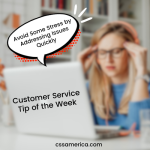You’re the customer, you’re asking about an unused item that you’re returning, and you hear the employee say: “The refund process takes 7-10 days.” You’re thinking: “Great! I can get the refund check as early as a week from today!” The reality is that the company means that they’ll mail the check 7-10 business days after processing it – which takes 48 hours to process.
Therefore, in 2 days, it could be 14 calendar days (10 business days) before they mail it, which could add 3-5 days. So yes, the refund may arrive 21 days from today, even though you thought it would be 7 days. What the company said may be truth to them, but what the customer hears makes what was said seem misleading.
You’re the customer, you’re calling about an account issue, and you hear the employee say: “I can help you with that.” They go through a series of questions, confirm your account, and eventually tell you that they’re going to send the issue to their escalation team. They’ll e-mail you back in 2-3 days.
When the employee said “I can help you with that,” you thought it meant that they could resolve the issue during the call. Instead, in 2-3 days, you’ll find out if they can address the issue at all.
There are times when the employee has the best intent, but the words they use or the script they’re provided misleads the customer. It’s likely not intentional, but it’s also how frustration and mistrust can build.
Look at your scripts and the wording you use, and don’t assume that the customer interprets it the same way that it’s intended.
Don’t let a truth to the company become a lie to the customer.
Signup for FREE Tips! Contact Us More Resources for You Visit Our Home Page
























